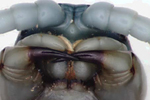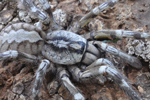Scientists in Brazil have described a new species of tree-dwelling porcupine in the country’s most endangered ecosystems. The description is published in last week’s issue of Zootaxa.
A team of researchers led by Antonio Rossano Mendes Pontes [2009 interview], a biologist at the Federal University of Pernambuco, found the porcupine in a small forest fragment in the state of Pernambuco. They christened the rodent Coendou speratus, a combination of its local name “coandu-mirim” and the Latin word “speratus” for “hope”.
The name choice is appropriate given the porcupine’s high risk of extinction. About 98 percent of its forest habitat has been destroyed, while its population is as fragmented as the forests it inhabits, making the species vulnerable in inbreeding, according to the researchers. The species is also actively hunted by locals.
 Coendou speratus. Image courtesy of Antonio Rossano Mendes / Universidade Federal de Pernambuco
Coendou speratus. Image courtesy of Antonio Rossano Mendes / Universidade Federal de Pernambuco
Coendou speratus shares the Northeastern Atlantic Forest habitat with another larger species of porcupine that dwells in the forest canopy. Coendou speratus lives at mid-height and is primarily nocturnal, sleeping in tree hollows during the day. It feeds on seeds.
The Northeastern Atlantic Forest is the most endangered habitat in Brazil. Most of the ecosystem, which lies in the states of Pernambuco and Alagoas, has been logged and converted for agriculture and cattle pasture. Pontes told the Associated Press that many of the species that originally inhabited the region are now locally extinct.
The Northeastern Atlantic Forest is part of the broader Mata Atlântica or Atlantic Forest ecosystem that once extended from Northeast Brazil to Argentina. It too has been greatly reduced, today covering less than 10 percent of its original extent.
The Mata Atlântica is considered one of the world’s biodiversity hotspots. Scientists have recorded 264 mammal species, nearly 1,000 birds, 456 amphibians, over 300 reptiles, and 350 freshwater fish in the ecosystem. Nearly a third of its species are endemic.
CITATION: Pontes et al (2013). A new species of porcupine, genus Coendou (Rodentia: Erethizontidae) from the Atlantic forest of northeastern Brazil. Zootaxa 3636 (3): 421–438 http://dx.doi.org/10.11646/zootaxa.3636.3.2
Related articles
Beautiful striped bat is the “find of a lifetime” (photos)

(04/10/2013) Scientists have uncovered a rare, brilliantly-striped bat in South Sudan that has yielded new secrets after close study. Working in Bangangai Game Reserve during July of last year, biologist DeeAnn Redeer and conservationist Adrian Garsdie with Fauna & Flora International (FFI) came across an unmissable bat, which has been dubbed by various media outlets as the “badger bat” and the “panda bat.”
Looking beyond the hundred legs: finding new centipedes in India requires many tools

(04/08/2013) A small, boneless creature, that lives underground, with a “hundred” legs, and a rather powerful sting; some of these creatures are drab, but some are so beautiful and brightly colored that they can startle. Centipedes. There is more to a centipede than its many legs, and its habit of darting out of dark places. One of the first lifeforms to turn up on land, some centipede fossils date back to about 450 million years ago. They have been evolving steadily since, with some estimates showing about 8,000 species today. Not even half of these species have been taxonomically described.
New giant tarantula that’s taken media by storm likely Critically Endangered (photos)

(04/04/2013) Described by a number of media outlets as “the size of your face” a new tree-dwelling tarantula discovered in Sri Lanka has awed arachnophiliacs and terrified arachnophobes alike. But the new species, named Raja’s tiger spider (Poecilotheria rajaei), is likely Critically Endangered according to the scientist that discovered it in northern Sri Lanka.

(09/23/2009) The Atlantic Forest may very well be the most imperiled tropical ecosystem in the world: it is estimated that seven percent (or less) of the original forest remains. Lining the coast of Brazil, what is left of the forest is largely patches and fragments that are hemmed in by metropolises and monocultures. Yet, some areas are worse than others, such as the Pernambuco Endemism Centre, a region in the northeast that has largely been ignored by scientists and conservation efforts. Here, 98 percent of the forest is gone, and 70 percent of what remains are patches measuring less than 10 hectares. Due to this fragmentation all large mammals have gone regionally extinct and the small mammals are described by Antonio Rossano Mendes Pontes, a professor and researcher at the Federal University of Pernambuco, as the ‘living dead’.